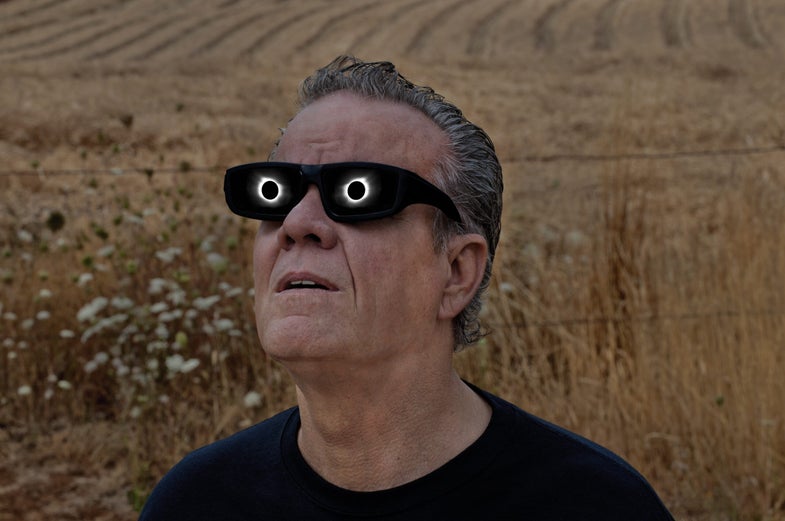How to make sure your eclipse glasses actually work
Don't fry your eyeballs with counterfeits.

You’ve planned your road trip, downloaded your science apps, and bought yourself a pair of shiny new spectacles: you’re ready for the eclipse. But is your eyewear is up to the task?
With the Great American Eclipse approaching, demand for eclipse glasses—with special lenses designed to keep the sun from harming your peepers—is surging. And counterfeit glasses are everywhere. In fact, Amazon is so swamped by reports of possibly unsafe glasses that the company is allegedly sending out recalls and refunds for products that are certified as eclipse-safe.
How can glasses be counterfeit?
It’s supposed to be super simple to determine the effectiveness of eclipse lenses. The International Organization for Standardization (ISO) uses a standard called ISO 12312-2 to certify these products. To achieve ISO 12312-2 compliance, companies have to file paperwork proving that their lenses block a certain amount of UV light. If they meet that standard, then the business can label those glasses with the appropriate ISO certification number printed on their product.
This is because having appropriately darkened glasses is crucial to safe eclipse viewing. If you’re actually on the path of totality—where the sun will be totally blocked out by the moon for a minute or two—it’s safe to stare up at the phenomenon without glasses during that brief period of complete darkness. But during a partial eclipse (which will make up the bulk of the event no matter how good your viewing spot is) you must protect your eyes.
You probably realize that staring up at the sun can damage your retinas. During an eclipse, you run the risk of being surprised by the sun’s return. Imagine that the sun is hidden enough by the moon that you feel comfortable staring at it—you don’t reflexively squint. Now imagine staring just a few seconds too long, and suddenly getting hit with a bigger blast of UV radiation. It’s not a good time.
The ISO 12312-2 certification guarantees that your eyes will actually be protected as you gaze skyward. Unfortunately, there have been many reports of factories stamping the ISO label on glasses that haven’t actually been certified. Sure, some of these may be using the same lenses as certified products—with the rush to sell a brand new product, some companies surely skipped the hassle of certification even if their lenses would have passed—but is that a risk you’re willing to take? It shouldn’t be.
How can I know if my glasses are safe?
Now that spotting a label isn’t enough, things have gotten a little trickier. Luckily, the American Astronomical Society (AAS) has a running list of certified companies. They even list which brick-and-mortar retail stores are selling the right brands. In the totality-laden state of Oregon, for example, folks getting glasses from McDonald’s are all set. Also included are some of those random third party sellers on Amazon—the ones you buy stuff from without even realizing, most of the time—so you can vet more of your online purchases.
If your glasses are from a reputable source, all you have to do is actually wear them. Make sure they’re not scratched or torn—these aren’t the sunglasses you leave knocking around at the bottom of your tote bag, they need to provide full, unmarred coverage—and be sure not to use an unfiltered camera of any kind while you have them on, as the concentrated light may render them ineffective. According to the AAS, you don’t need to worry about limiting your time in the specs; some glasses will warn against more than three minutes of use, but ISO-certified glasses made after 2015 can be used indefinitely.
Here are a couple of highly-rated options that should arrive in time for your eclipse party.
My brand is supposed to be safe, but how do I know they’re for real? Can I test them?
According to the AAS, you can’t really check whether lenses are ISO-compliant without the proper equipment—so you use unapproved lenses at your own peril, no matter how carefully you test them at home.
But if you’re just looking to double check glasses that are meant to be safe, put them on and make sure you can’t see any light that’s not as bright as the sun. Your smartphone LED flashlight will do the trick. For starters, pop your glasses on and look around. Can you see anything? If so, they’re bogus.
If you’re still very much in the dark, move on to testing with an LED flashlight. I turned my phone’s flashlight on full blast and sheepishly angled it towards my (lens-protected) eyes. All I could see were a couple of dim little dots, even when I brought the light right up against my glasses. I was so impressed that I took the glasses off to compare just how bright the light was without a filter. Do not do this, as it negates the entire purpose of this article.
We can’t recommend that you use anything but certified glasses from a reputable seller. But if you can shine an LED in your face and barely see a single pinprick of dim light, your glasses are probable ready to handle an eclipse.
Now that I don’t trust any of my eclipse glasses, how can I still watch the darn thing?
It’s disconcerting to know that the market is flooded with dangerous fakes, so you might not feel safe even with glasses that you’re fairly certain are certified. If you’re not willing to put your vision on the line, consider using a projection method. The pinhole camera is a classic choice, and all you need to make one is a couple sheets of paper and a pin.
